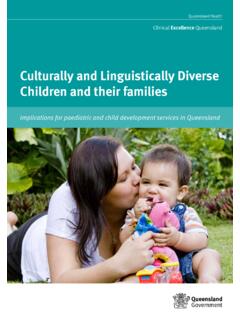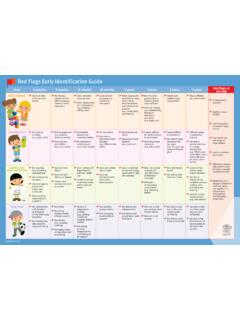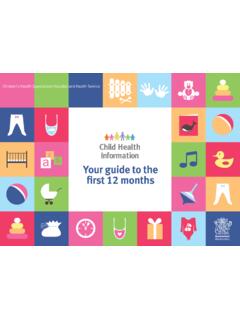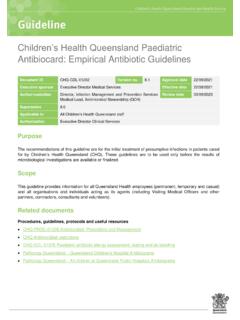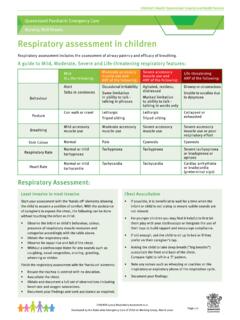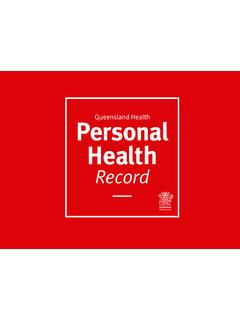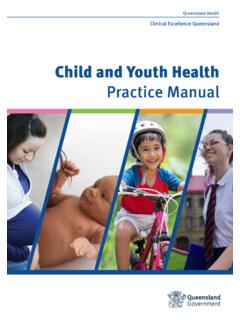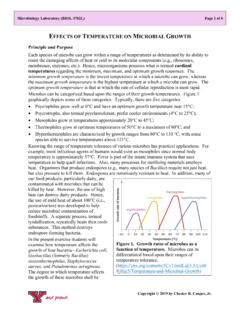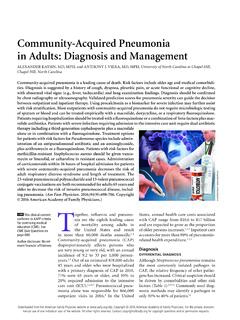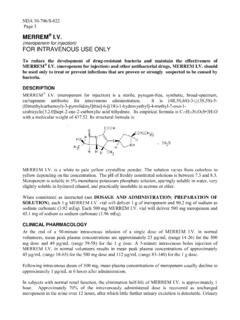Transcription of Otitis Externa: Emergency Management in Children
1 CHQ-GDL-00720 Otitis Externa: Emergency Management in Children - 1 - Otitis Externa: Emergency Management in Children Document ID CHQ-GDL-00720 Version no. Approval date 29/08/2019 Executive sponsor Executive Director Medical Services Effective date 29/08/2019 Author/custodian Director Paediatric Emergency Medicine, CHQ Review date 29/08/2022 Supersedes Applicable to Emergency Department Medical & Nursing staff working at Children s Health Queensland Authorisation Executive Director Clinical Services (QCH) Purpose This procedure provides guidance to clinicians involved in Emergency department Management of Children with Otitis externa. Scope This guideline applies to all staff involved in the acute care and Management of Children with Otitis externa. Introduction Acute Otitis externa (AOE) is defined as diffuse inflammation of the external ear canal, which may also involve the pinna or tympanic AOE is a form of cellulitis that involves the skin and sub dermis of the external auditory canal, with acute inflammation and variable oedema1.
2 It is most commonly caused by bacterial infection of the external ear canal following ,6 The most common pathogens isolated from culture are pseudomonas aeruginosa and/or Staphylococcus aureus. Other pathogens both bacterial and fungal are much less common, though Candida or Aspergillus species are often the alternate pathogens found on culture, particularly after prolonged antibiotic The diagnosis of AOE requires the presence of rapid onset of symptoms (generally within 48 hours) within the past 3 weeks, coupled with signs of ear canal inflammation1,9. AOE has a lifetime incidence of 10%.1,3,8 AOE is prevalent worldwide and is known to affect people of all age groups but is found to peak in the 5 - 14 year old age group and decline with increasing age. The incidence of AOE is increased in summer months due to a causal relationship with prolonged water exposure and high humidity9, hence its colloquial name of swimmer s ear.
3 Otitis externa has acute (<6 weeks), chronic (>3 months), and necrotising (malignant) forms and may present as a single episode or may recur. CHQ-GDL-00720 Otitis Externa: Emergency Management in Children - 2 - The pathophysiology of AOE is attributable to the decreased integrity of the external auditory canal, whose protective environment is usually hydrophobic, acidic and containing a protective ceruminous layer. Disruption of this environment therefore exposes the epithelium of the external canal to water and bacterial Infection of the external canal epithelium leads to an acute inflammatory reaction causing erythema and oedema of the canal. Symptomatically this results in otalgia, ottorhea, pruritus and jaw pain. If oedema is severe, hearing loss may result from occlusion of the A number of factors can contribute and predispose certain individuals to a higher risk of ,2,8,9 Water exposure Localised or generalized eczema Immunocompromised patients Diabetes Mellitus Use of hearing aids, plugs or cotton ear buds Anatomical obstructions (exostoses or canal stenosis) Physiological (decreased ear wax production) Assessment Diagnosis of AOE requires a rapid onset (<48hours) of signs or symptoms of external auditory canal inflammation with or without infection.
4 The typical signs and symptoms are: Otalgia (exacerbated by manipulation of ear) Pruritis (more commonly associated with fungal infections) Tenderness of tragus and pinna External canal oedema Erythema Otorrhoea Unilateral (~90% of AOE cases) Jaw pain Conductive hearing loss Aural fullness Thorough examination of the external ear and ear canal should be undertaken. If otorrhoea is present, swabs should be taken. The tympanic membrane should be visualised if oedema is not completely occluding the external canal, in order to rule out perforation or presence of grommets, which could alter the treatment course in regards to ototoxic topical drops. The external auditory canal and conchal bowl should be inspected for vesicles that could be indicative of herpes zoster infection or for fungal Care must be taken to distinguish AOE from other potentially more sinister causes of external ear pain with differential diagnosis including but not limited to furunculosis, herpes zoster oticus, otomycosis, chronic Otitis CHQ-GDL-00720 Otitis Externa: Emergency Management in Children - 3 - externa, malignant (necrotising or skull base osteomyelitis) Otitis externa, acute Otitis media with perforation, contact dermatitis, squamous cell carcinoma or adenocarcinoma of external auditory canal and retained foreign body, as these will all have varying treatment.
5 Paramount to physical examination is a targeted history to identify high risk patients who have the potential for alternate diagnosis requiring targeted investigation or imaging and with differing treatment course or potential disposition and follow up. Management The Management of simple AOE is targeted at both symptomatic control of otalgia and topical antibiotic treatment. Initial antibiotic therapy should be empiric, progressing to specific treatment based on sensitivities once results are obtained from swabs. Analgesia should be promptly initiated and continued in accordance with a graduated severity analgesic regime; commencing with simple oral analgesia, paracetamol and/or ibuprofen, and escalating as necessary for the individual patient s requirements. Once analgesic requirements have been addressed, examination and history taking for assessment and definitive diagnosis should be completed. If possible obtain a microscopy/culture/sensitivity (M/C/S) swab of otorrhoea or debris within the external auditory canal.
6 If otorrhoea is present, dry aural toilet6 should be performed to remove debris and discharge. Dry aural toilet involves dry mopping the ear with rolled tissue spears or similar every six hours until the external canal is dry. If nothing on examination or history is indicative of the need to modify treatment or investigation and simple AOE is the working diagnosis, the following steps should be performed for definitive ,5,6,9 1. Dry aural toilet (syringing ear should be STRICTLY avoided). 2. Administer combination corticosteroid and antibiotic ear drops. Topical corticosteroid and antimicrobial dosing for Children acute Otitis externa No perforation Dexamethasone + framycetin + gramicidin ear drops (SOFRADEX ) Three drops instilled into the affected ear, three times daily for seven days. Perforation Ciprofloxacin ear drops (CILOXAN ) Five drops instilled into affected ear two times daily for seven days. 3. If suspected pseudomonas Otitis externa with either significant canal wall oedema or associated with myringitis, infected grommets with granulations, or infected cholesteatoma with polyp/granulations Topical corticosteroid and antimicrobial dosing for Children with complicated acute Otitis externa Complicated Ciprofloxacin + Hydrocortisone 1% ear drops (CIPROXIN HC ) Three drops instilled into the affected ear, twice daily until symptoms have cleared for 2 days.
7 Duration not exceeding 2 weeks. ALERT: Ciproxin HC is not on the PBS or LAM. If used for the indications listed in this CHQMAC endorsed guideline, Individual Patient Approval is not required. All other use will require individual patient approval signed off by ID CHQ-GDL-00720 Otitis Externa: Emergency Management in Children - 4 - 4. If fungal infection is suspected: Topical antifungal dosing for Children with suspected fungal acute Otitis externa Fungal Triamcinolone acetonide + neomycin sulfate + gramicidin + nystatin 100,000 units/mL ear drops (KENACOMB/OTOCOMB ) Three drops instilled into the affected ear, three times daily for 7 days. 5. Insertion of a wick to facilitate administration of drops is recommended in situations of significant canal oedema. A wick allows drops to bypass oedema and enables administration to the infected area. Insert a dry wick into the external ear canal, then administer drops as per above.
8 6. Review 48-72 hours after initiation of treatment by primary care physician to check clinical progress and review culture results is recommended. 7. Referral to ENT outpatient clinic is indicated for uncontrolled or severe pain and/or failure of resolution within a reasonable time frame, for example two weeks. An important component of the treatment of AOE is maintaining strict water precautions for 10-14 days. This involves refraining from water sports and taking precautions during bathing. It is also advised not to use headphones during the recovery period. ALERT: System Antibiotics Systemic antimicrobials should not be prescribed as initial therapy for diffuse, uncomplicated AOE unless there is extension outside the ear canal or the presence of specific host factors that would indicate a need for systemic therapy. This should then be discussed with ENT Registrar prior to prescription. ALERT: Preparations Non-ototoxic preparation should be prescribed when the patient has a known or suspected perforation of the tympanic membrane, including a tympanostomy tube (grommet).
9 CIPROFLOXACIN is the drug of choice. ALERT Frequent use of topical ciprofloxacin increases the likelihood of local bacterial resistance particularly in pseudomonas . Complications Malignant (necrotising or skull base osteomyelitis) Otitis externa is a serious and potentially fatal complication of AOE. This complication affects immunocompromised individuals such as those with chemotherapy-induced aplasia, refractory anaemia, chronic leukaemia, lymphoma, splenectomy, neoplasia and renal transplantation2. Pathophysiology in this case reflects spread of the infection through the floor of the external auditory canal to the base of the skull, with associated formation of granulation tissue. P. aeruginosa is the most common cause CHQ-GDL-00720 Otitis Externa: Emergency Management in Children - 5 - however fungal pathogens can also cause the condition especially in patients with AIDS, in whom Aspergillus fumigatus is the most common pathogen. These patients have typically failed appropriate topical and/or systemic antibiotic therapy.
10 On examination the external auditory canal may show presence of granulation tissue or a polyp on the floor of the canal, as well as exposed bone. Extension into the skull base may result in cranial neuropathies, with the facial nerve most commonly involved. Carcinoma of the ear canal has a similar appearance and biopsy is necessary to rule out All suspected cases of malignant Otitis externa should be discussed with ENT in a timely manner. Disposition Due to the generally uncomplicated nature of AOE, disposition of patients is usually discharge from hospital with close follow up arranged either with a primary care physician at the 48-72h mark or in ENT outpatient clinic (especially if ear toilet is required). Advice should be given about the prevention of recurrence particularly ensuring ears are dry post water sports and consideration of the use of ear plugs. If analgesic requirements are significant then consultation with ENT registrar for review or admission to hospital may be required.


